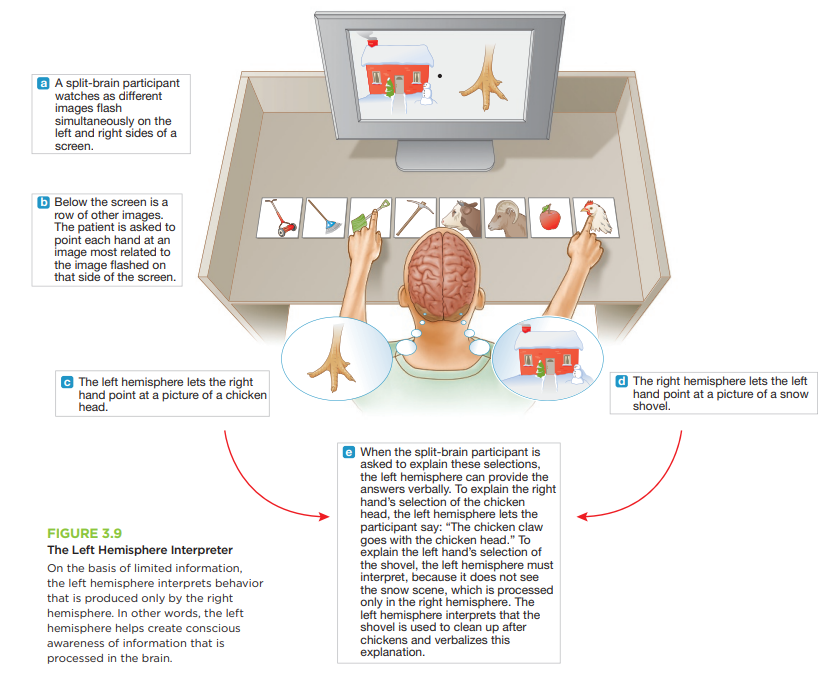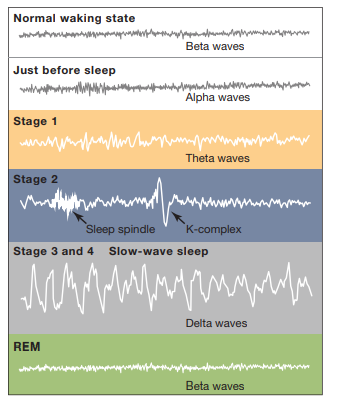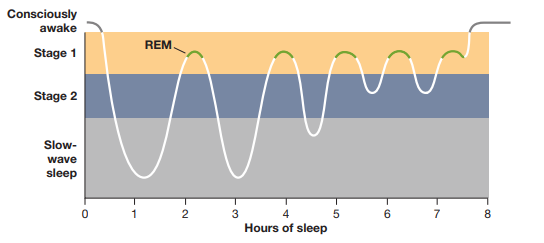Chapter 3 - Consciousness
- Consciousness - is the combination of a person’s subjective experience of the external world and their internal mental activity. (the combination results from brain activity)
- Conscious: Level of consciousness that reflects awareness of the external environment and inner mental activity
- You are aware of your surrounding stimuli and your thoughts
- Unconscious: level of consciousness that reflects @@a lack of awareness@@ of the external world and inner mental activity
Objective vs Subjective
- Objective: considering information as an object that %%exists apart from your opinion%% of it
- experiencing something for itself, without the influence of your emotions (unbiased), for example: this book is 109 pages long.
- Subjective: Consider information as a %%subject%% %%to your opinion%%.
- experiencing based on your own personal opinions (biased), for example: this cake has too much frosting.
States of Awareness:
- Normal Waking State of Consciousness: a state that reflects @@clear@@ awareness of the external world and internal mental activity.
- Altered State of Consciousness: a state that deviates from a normal waking state. It may reflect either move vivid awareness or less clear awareness of the external world and your internal activity.
Below are examples of the Altered States of Consciousness:
| Created by disease or Brain Injury | Occurring Normally | Self Induced |
|---|---|---|
| Concussion | Day Dreaming | Hypnosis |
| Traumatic Brain Injury | Falling Asleep | Meditation |
| Coma | Dreaming | Flow |
| Watching Television | Use of drugs and alcohol |
The Nature of Consciousness
- Dualism: the mind is separate from the rest of the body
- A view held by philosopher Rene Descartes (not a very popular opinion)
- Materialism: the modern idea that the mind and body are inseparable
- The activity of neurons in the brain produces consciousness
Global Workspace Model: psychological theory - consciousness depends on which brain circuits are active.
 The key idea of this theory: no specific part of the brain is responsible for awareness. Instead, the processing in different brain areas produces a conscious experience of the information
The key idea of this theory: no specific part of the brain is responsible for awareness. Instead, the processing in different brain areas produces a conscious experience of the information
This also means that damage to specific brain regions can negatively affect consciousness.
- Traumatic Brain Injury (TBI): external trauma causes changes in consciousness and physical damage to the brain.
- the more significant the injury the more the TBI negatively affects consciousness. This includes thinking, emotions, memory, and even personality changes that can last many years or remain permanent.
- Coma: a person is unable to give an ^^outward sign^^ of awareness
- minimally conscious state: the person in the coma is conscious, but the patient is unable to make their body respond, observers, think they are unconscious.
- unresponsive wakefulness syndrome: when a coma lasts for ^^more than a month^^. This is often because the brain is damaged beyond recovery.
Attention and “the 2 tracks”
- Attention: the focusing of mental resources to become consciously aware of specific information.
Daniel Kahneman proposes the “two-track mind,” to explain how different levels of attention produce awareness.
- Automatic Processing: fast, doesn’t require too many mental resources
- Example: driving to a familiar place. You %%aren’t likely to remember%% what you saw during the drive.
- Controlled Processing: slow, requires more mental resources focused on the task
- Example: driving in terrible weather conditions. You %%will remember%% seeing cars skidding near you, or how anxious you felt as you drove
Having two mental tracks doesn't mean we can multitask endlessly. We have a limited amount of attention to consciously experience and respond to info.
- change blindness: failure to be aware of visual information when one’s attention is focused elsewhere.
- Research Example (from the textbook): participants were approached by a stranger, who asked for directions. Then the stranger was momentarily blocked from the participants’ view by a large object and replaced with another person of the same sex and race. Surprisingly, half of the people giving directions never noticed that they were talking to a different person. (this shows that if we don’t pay attention to certain features, we are unaware of them)
Unconscious Processing
Subliminal Perception: our sensory systems process stimuli without our awareness.
- Research Example (from the textbook): Indeed, the researchers found that when given the word pair ocean– moon, followed by the word detergent, participants typically said the word tide. Because the moon affects the ocean and the tides. When the participants were asked why they said “tide,” they usually gave reasons about the detergent’s brand name. This response shows that participants were not aware that the word pair had influenced them.
Split Brain: a condition in which the corpus callosum is surgically cut and the two hemispheres of the brain do not receive information directly from each other
- Corpus Callosum: the bundle of nerve fibers that allow the left and right hemispheres to communicate.

Consciousness and Sleep 😴
- Circadian Rhythms: the regulation of biological cycles into regular and daily patterns.
- sleep/wake cycles work according to the circadian rhythm
- the rhythm is influenced by cycles of light and dark, but even when removed from light cues the cycle remains.
- Melatonin: the hormone that helps regulate circadian rhythm.
- Bright light = reduces the production of the hormone
- Darkness = increases the production of the hormone
The 4 Stages of Sleep
Electroencephalography helps researchers measure the brain’s electrical activity.
- Beta waves = neurons in your brain are very active
- Alpha waves = when you relax, brain activity slows down
You begin to drift off. Your awareness of both the outer and inner worlds begins to decline. You may have a sensation of falling or your limbs jerking.
You are truly asleep. Your breathing becomes regular, and you are even less aware.
- Sleep spindles signify occasional bursts of activity. As people age, fewer sleep spindles show up.
- K-complexes are triggered by abrupt noises, it may be signals from the brain helping the person stay asleep.
Deep sleep, slow wave sleep. People in this stage are very hard to wake up, and if they do wake up they are often disoriented. People still process some outside info in this state because the brain is evaluating for threats
REM sleep. After 90 minutes, the brain returns to stage 1, but as it resets, the brain becomes very active, but the body continues to sleep
- a person experiences rapid eye movements, dreaming, and paralysis of motor systems
- Some regions of the brain become more active than if it was in the normal waking stage.
On a typical night, you go through the four stages of sleep about 5 times. As the morning approaches, the cycles become shorter.


Dreaming 💭
- Dreams: products of consciousness during sleep in which a person confuses images and fantasies with reality.
You dream during both REM and non-REM sleep:
- REM dreams: tend to be bizarre. They often involve auditory and visual hallucinations and intense emotions
- Brain show increased activity in areas associated with motivation, reward, and emotion.
- Non-REM dreams: feel like normal everyday life.
- Many regions of the brain are generally deactivated.
What do dreams mean?
- Manifest Content: The way visual information is seen and remembered by the dreamer
- Latent Content: the meaning behind the visual content
Some theories believe that manifest content hides the dreamer for the latent content to protect them from directly confront their unconscious conflicts.
- Activation Synthesis theory: neurons fire randomly during sleep, this results in activating parts of the brain that process sensory input.
- When the sleeping mind tries to make sense of the “input” it results in dreams
- Developed by sleep theorists Johan Allan Hobson and Robert McCarley to explain dreaming.
3 Benefits of Sleep
- Restorative Theory: sleep helps the body and brain repair itself
- Growth hormones release to help repair damaged tissue. Sleep also helps refill energy stores and strengthen the immune system
- Circadian Rhythm Theory: sleep helps save animals and humans from harm
- Creatures sleep at night, a time when it is very dangerous for many creatures. Sleeping hidden helps them remain silent and helps protect them from threats
- The less time a creature needs to protect itself, hunt for food, and complete its survival necessities, the longer it sleeps.
- Consolidation Theory: sleep is important for learning
- connections made during the day are strengthened at night
Common Sleep Disorders
- Insomnia: repeated inability to sleep
- Results in reduced mental health and ability to function
- Sleep Apnea: while sleeping, a person’s throat closes therefore stopping their breathing.
- Results in multiple awakenings during the night
- Narcolepsy: a person experiences excessive sleepiness during normal waking hours. Sometimes, they even go limp and collapse
- REM behavior disorder: people act out their dreams while sleeping
- the normal paralysis that accompanies REM sleep is disabled
- Somnambulism (sleepwalking): the person is glassy-eye and seems disconnected from their surroundings. They aren’t acting out their dream
- Common among young children, typically within the first 1 or 2 hours of sleep
Consciousness in Hypnosis 😵💫
Hypnosis: an interaction where the person responding to suggestions experiences changes in memory, perception, or voluntary action.
- Posthypnotic suggestions: commands issued by the hypnotist and the hypnotized person are expected to follow.
- Note: hypnosis has some effect but it isn’t permanent.
sociocognitive theory of hypnosis: hypnotized people are not in an altered state of consciousness, but they behave in a way that is expected in that situation
- the person isn’t faking, but he acts the part of being hypnotized while being fully aware and willing to do what the hypnotist directs.
dissociation theory of hypnosis: hypnotized people are in an altered state of consciousness where their awareness is separated from other aspects of consciousness. (a trance)
Hypnotic Analgesia: a form of pain reduction
- a person's with their arm in ice cold water can last ~30 seconds. A person under hypnosis can last longer
Drugs and Consciousness 💊
- Psychoactive Drugs: Mind-altering substances that change the brain’s neurochemistry.
- Use results in an altered state of consciousness
- Stimulant: a psychoactive drug that increases behavior and mental activity
- Depressant: a psychoactive drug that ^^decreases^^ behavior and mental activity
- Opioid: a psychoactive drug that reduces pain and produces pleasure
- Hallucinogen: a psychoactive drug that affects perceptual experiences and evokes sensory images without sensory input.
Addiction
- Addiction is when a behavior remains compulsive despite its negative consequences.
- Developing a tolerance to a drug, means you need to consume more of that drug to have the same effect
- physical dependence
- An individual experiences withdrawal when they don’t ingest the drug
- Physical and psychological state: anxiety, tension, and craving for the drug
While more than 90 million Americans have experimented with illicit drugs, only 5-10 percent of them becomes addicted.